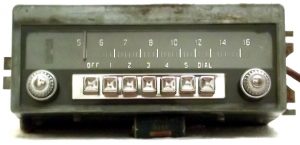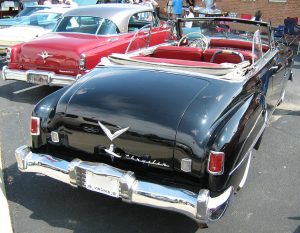The model is Philco C-5109 (Mopar 815), installed in the cars Chrysler Windsor, Saratoga, New Yorker in 1951-52.
It is indeed a set of the early ’50s, running at 6 volts, with 8 tubes and able to receive standard broadcast only. Beyond the manual tuning, it has 5 pre-tuned stations which can be selected with the nice chromium-plated push-button panel.The audio amplifier includes a push-pull output stage with two 6AQ5, driven by a 6C4 phase inverter triode, in this case the grids of the output tubes are connected respectively one to the cathod and the other to the anode of the triode.
 The high-voltage power supply stage of the anode, like all other car radios of this time, is equipped with an electromechanical inverter, known as vibrator and with a concept similar to door bells and buzzers, whose tasks is to transform the direct current of the battery into alternating current, creating a square waveform. This is then sent to a transformer to increase the voltage up as needed. A rectifier tube transform the current out from the transformer into direct current, so that it can be used to power up the tubes. Thanks to the (square) waveform, the filter capacity doesn’t need to be high: in fact, the electrolytic capacitors are rather small.
The high-voltage power supply stage of the anode, like all other car radios of this time, is equipped with an electromechanical inverter, known as vibrator and with a concept similar to door bells and buzzers, whose tasks is to transform the direct current of the battery into alternating current, creating a square waveform. This is then sent to a transformer to increase the voltage up as needed. A rectifier tube transform the current out from the transformer into direct current, so that it can be used to power up the tubes. Thanks to the (square) waveform, the filter capacity doesn’t need to be high: in fact, the electrolytic capacitors are rather small. After drying the radio, I tried to power it up: I normally use a dual power supply from my lab instruments, able to supply 3 ampere, which was going into overload protection because of the radio. I wasn’t sure whether this was normal or not, and since I hadn’t at the moment anything able to supply higher current, so I decided to continue in a different way.
After drying the radio, I tried to power it up: I normally use a dual power supply from my lab instruments, able to supply 3 ampere, which was going into overload protection because of the radio. I wasn’t sure whether this was normal or not, and since I hadn’t at the moment anything able to supply higher current, so I decided to continue in a different way. in order to be able to increase resistance value and adjust the output voltage within a certain limit.
in order to be able to increase resistance value and adjust the output voltage within a certain limit.Unfortunately the potentiometer of the tone control was in series with a leaking capacitor, also connected to an anode of a tube.  These American capacitors, when leaking, show a really strong leakage, so the potentiometer was reached by 70 volt, enough to cut it off. Since it was still partly working, and it was difficult to disassemble it, I left it untouched, but added a resistor with same value in parallel, to avoid breaking the circuit where it was inserted. This radio has a negative feedback to improve the audio quality and the reducing the distortion.
These American capacitors, when leaking, show a really strong leakage, so the potentiometer was reached by 70 volt, enough to cut it off. Since it was still partly working, and it was difficult to disassemble it, I left it untouched, but added a resistor with same value in parallel, to avoid breaking the circuit where it was inserted. This radio has a negative feedback to improve the audio quality and the reducing the distortion.
















